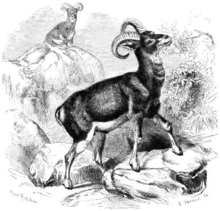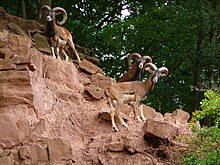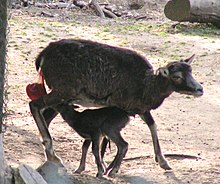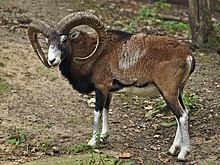European mouflon
| European mouflon | ||||||||||||
|---|---|---|---|---|---|---|---|---|---|---|---|---|

European mouflon ram ( Ovis gmelini musimon ) |
||||||||||||
| Systematics | ||||||||||||
|
||||||||||||
| Scientific name | ||||||||||||
| Ovis gmelini musimon | ||||||||||||
| ( Pallas , 1811) |


The European mouflon ( Ovis musimon gmelini , Syn. : Ovis orientalis musimon , Ovis aries musimon ), hunter linguistically mouflon or short muffle called, is the westernmost and smallest subspecies of wild sheep . Originally it was only widespread on the Mediterranean islands of Corsica and Sardinia , but has now been introduced in numerous areas of Europe .
Designations
The males of the mouflons are called rams and the females sheep or wild sheep. The young are called lambs and, depending on their gender, are also called ram lamb or sheep lamb. In hunting terminology, female animals are called narrow sheep from the age of one to the point in time at which they have offspring for the first time. Giving birth is called sitting or lambing.
Appearance
European mouflons have a body length of up to 120 cm, a shoulder height of 90 cm, a weight of 25 to 40 kg for sheep, 35 to 55 kg for rams. The European mouflon has a smooth coat, the rams are fox-red-brown in summer, usually with a whitish saddle mark, the sheep are brownish. In winter both sexes are darker. The rams have horns up to 80 cm long, twisted in a snail shape, females on Sardinia have no horns at all, while on Corsica they have smaller, slightly curved horns.
Senses
As a resident of an originally forest-less region above the tree line, mouflons have good eyesight. The side-facing eyes allow the mouflon to see a wide area without turning its head. In older rams, the field of vision can be restricted by the position of the horn tips. Aries then begin to scrape off these horn tips. The binocular vision is limited to a relatively small field of view of 60 percent, only in that they can see in space. In the rest of the field of vision, mouflons mainly perceive movements. If mouflons are disturbed by a movement in their lateral field of vision, they turn their head to this object in order to locate the object in the depths of the landscape. Only then do they try to gain additional information by checking the wind and their sense of hearing in order to assess the danger of the disorder. People can still be seen from a distance of 1,000 meters. The sense of sight also plays a significant role in keeping the pack together. Mouflons that have lost touch with their pack first look for it by excitedly running back and forth. Only then do they use their sense of smell to follow the pack. Hearing plays a role in maintaining the social relationship among the members of the pack.
Vocalizations
The sound repertoire of the mouflons is extensive and can be divided into contact, warning and lamenting sounds as well as the luring of raging rams. Just a few minutes after the birth of the lamb, the sheep let out a short, dark grumbling, to which the lamb also responds with grumbling. In the pack, the sheep call for their lambs with a drawn out moan. Lambs looking for their mother let out a bleating. Wailing sounds can be heard by lambs when they are grabbed by an enemy or when they are seriously injured. No complaints can be heard from older mouflons.
When alarmed, mouflons let out a hissing sound emitted through their nostrils. Often the warning call is preceded by a nervous stamping with the forelegs. The warning call is quiet if a mouflon is just a little worried, but is emitted significantly louder when danger is approaching. A pack whose lead sheep utters this sound immediately flees. If the sound is uttered by another pack animal, the pack begins to secure, but waits for the reaction of the lead sheep.
Aries make a rattling and rasping sound when driving sheep in heat. The clapping of horns is one of the most widely audible sounds made by mouflons. It is most commonly heard during the rutting season, however rams fights all year round.
distribution and habitat
The European mouflon is found in Corsica and Sardinia , where it lives in open mountain landscapes on stony, dry soils. Here he was endangered by hunting and poaching. Only strict regulations and resettlements seem to slowly stabilize the population. In Corsica, where mouflon hunting has been banned since 1953, only around 180 mouflons lived in 1967, and by 2010 the population had grown to 800 individuals. In Sardinia the population was around 700 animals around 1955, in 1967 only around 300 specimens. Protection programs increased the population to over 1,000 individuals by 1980. In 2015, an estimated population of 6,000 mouflons was identified in Sardinia.
Since the 19th century, the European mouflon was also increasingly naturalized in Central Europe . Here it lives in deciduous and mixed forest areas both in the lowlands and in the low mountain ranges , whereby dry and stony soils are also preferred.
behavior
European mouflons usually form small packs with an older sheep as the leader. Aries often form their own associations outside of the rutting season . During the rutting season, the rams fight for the sheep, especially with mutual ramming of the twisted horns in order to drive away the competitor. European mouflons are herbivores and have a wide range of foods. They also debark forest trees and largely prevent tree growth from growing. The rut is in October / November, the gestation period is about five months, the setting time is in March / April. One or two lambs are born and the suckling period is about six months.
The escape behavior of the European mouflons is adapted to their actual high mountain habitat: when threatened, they flee into inaccessible rock faces. Accordingly, they only flee short distances in the lowlands and are easy prey for pursuers.
The European mouflon as a neozoon
history
It is unclear whether the European mouflon was exterminated in Europe 3000 to 4000 years ago through habitat cutting and heavy hunting and only survived in Corsica and Sardinia, or whether it was only introduced into the Mediterranean region in prehistoric times. According to some zoologists, the European mouflon is not a real wild sheep, but rather a descendant of a very original domestic sheep breed. In fact, there is strong evidence that European mouflons only came to Corsica and Sardinia about 7000 years ago as companions of Neolithic humans, as no traces of them can be found from earlier times.
Over the past 200 years, European mouflons have been released in various places in Europe. Prince Eugene of Savoy already kept mouflon in his Vienna zoo, some of which ended up in the Lainzer zoo . In 1840 another 19 specimens from Corsica and Sardinia were introduced there. After twenty years of hunting, 60 rams could already be shot, and similar experiences were made with animals released a little later in Hungary, Bohemia and Silesia.
Since the beginning of the 20th century, they have been imported into Germany directly from Sardinia and Corsica as park and hunting game. Here it was primarily the Hamburg merchant Oscar Louis Tesdorpf who promoted naturalization. The first specimens were released in 1903 in the Göhrde , the next in 1906 in the Harzgerode district , then the Taunus and the Solling followed . Everywhere the mouflon preferred flat or low areas with forest vegetation and not, as expected, mountainous areas with rocks. Gradually there was a move to release mixed breeds of domestic sheep, in particular crosses with the racket sheep .
After a decline in the First World War, in 1938 there were already around 2,500 in the German Reich alone. After a new decline in World War II, the global inventory was only around 4,500 in 1954. After that, the stocks recovered due to careful management and had grown to around 20,000 in 1967. In the Federal Republic of Germany the stock at that time was 7,000, in Austria over 2,000 and in Hungary and Czechoslovakia also 2,000 pieces. After the Second World War, there were also individual new settlements. Mouflons were naturalized in the Bavarian Forest from 1971 to 1974 via the Wittelsbach Compensation Fund on the south side. In Luxembourg , in January 1969, some mouflons were brought from the grand-ducal enclosure near Imringen in Grünewald, where they had existed since 1905, to the state enclosure near Kaundorf in Ösling; they were released in 1970 and have spread in the Upper Sauer area. There are also mouflons in the Hosingen (Ösling) area and especially in the canton of Echternach (Gutland).
Todays situation
The main occurrences of the European mouflon are now in the Czech Republic , Germany , Hungary and Austria . Larger populations also exist in France , Slovakia , Serbia , Croatia and Bulgaria . The imported populations of Central Europe are estimated to have more than 60,000 animals (in 2005 it was 90,000), most of them 17,500 in the Czech Republic. The population in Germany was around 15,600 individuals in 2010 (in 2005 it was 20,600) in around 120 sub-populations. There are around 10,600 mouflons in Hungary and around 7,500 in Austria (no stocks in Vorarlberg ). At the beginning of the 1980s, animals migrated from France to the Swiss canton of Valais , where there are now two colonies with a population of around 200 animals. The IUCN lists the European mouflon as endangered.
The European mouflon population, which was introduced to Germany from Sardinia and Corsica over 100 years ago, is threatened by the (natural) return of wolves. One reason lies in the escape behavior of the wild sheep, which can save themselves on rocks and cliffs in their original home. There is hardly such a landscape in Germany. As a result, the wild sheep in the flatter landscapes of Central Europe with their short sprints have no chance against fast predators. Therefore, European mouflons can largely only keep here in the absence of predators. The mouflon population in the newly populated wolf territories of the Saxon Lausitz was wiped out by the wolves within a short time, while the population sizes of deer, wild boar and the main prey deer were not affected. In the Göhrde near Lüneburg, the 300 mouflon population disappeared within three years of the appearance of the wolf. Even in the low mountain range the circumstances are hardly different, as the example of the Harz currently shows, where the lynx occurs as a larger predator. The European mouflon had a similar experience in the Bavarian Forest. The stock, which was introduced there in the early 1970s and at times increased to almost 100 animals, fell to a little more than 30 specimens in the goat's head by early 2008 , caused among other things by the lynx, but also by tourism and hunting.
hunt
Mouflon deer have a well-developed sense of sight and, in comparison to deer, which mainly rely on the sense of smell, can recognize a person at over 1000 meters. In spite of their small size and weight, mouflon is "tough as a shot" and must be hunted with sufficiently strong calibers to ensure immediate success.
Germany
In Germany, the hunting of mouflons is regulated by the hunting law under the Federal Hunting Act. In the 2015/16 hunting season, the hunting distance in Germany was 8,000 mouflons (7,270 in 2010/11), 3,000 of which in Rhineland-Palatinate and Thuringia alone , which corresponds to 38 percent of the total distance. In contrast to some other hunted game species, the number of kills has been almost constant for more than ten years. The kills, which are quite high compared to the population, result from the intention to keep the population constant in order to limit game damage and to maintain a healthy population.
Austria
In the 2015/16 hunting season, the hunting distance in Austria was 2,450 mouflons (in 2014/15 there were 2,640), 885 of them in Lower Austria alone , which corresponds to 36 percent of the total distance. In Salzburg was the Green Party 's attitude in 2016 of u. a. Mouflons in hunting gates made public and criticized. The animal ethicist Martin Balluch declared that it is not compatible with today's understanding of animal protection to hunt and kill captured animals for entertainment.
literature
- Holger Piegert, Walter Uloth: The European mouflon. DSV-Verlag, Hamburg 2005, ISBN 3-88412-429-3 .
- Herbert Tomiczek, Friedrich Türcke : The mouflon. Natural history, protection and hunting . Kosmos, Stuttgart 2003, ISBN 3-440-09652-1 .
- Walter Uloth: The mouflon . Ovis ammon musimon. (= Die Neue Brehm-Bücherei. Volume 491). Westarp-Wissenschafts-Verlags-Gesellschaft, Hohenwarsleben 2004, ISBN 3-89432-175-X .
- Manfred Fischer, Hans-Georg Schumann: Mouflon. Talk to and hunt. Neumann-Neudamm, Melsungen 2004, ISBN 3-7888-0826-8 .
Web links
Individual evidence
- ^ Walter Frevert: Hunting customs and hunting language. Franckh-Kosmos, Stuttgart 2011, ISBN 978-3-440-12791-9 , pp. 213-214.
- ↑ Piegert et al., Pp. 10-11.
- ↑ Piegert et al., P. 11.
- ↑ Piegert et al., P. 13.
- ↑ Piegert et al., P. 13.
- ↑ Piegert et al., P. 13.
- ↑ Piegert et al., P. 13.
- ↑ Piegert et al., P. 13.
- ↑ Piegert et al., P.14.
- ↑ Sadegna Foreste: Censimento del muflone: report 2015
- ↑ Ludwig Zukowsky: From the forest and the hall. Animals of our homeland ; Cigarette picture service Hamburg-Bahrenfeld, 1939
- ↑ D. Müller Using in Grzimeks Tierleben , 1968
- ↑ a b The mouflon has become rare ; Der Bayerwald-Bote ( Passauer Neue Presse ), No. 15, January 18, 2008
- ↑ JA Massard & P. Kintziger: Le Mouflon (Ovis ammon musimon) au Luxembourg: notes historiques sur son introduction et analyze de la population des mouflons de la region de la Haute-Sûre. Bulletin de la Société des Naturalistes luxembourgeois 95 (1994), pp. 187-208. ( PDF )
-
↑ Mouflon in the Echternach Forest .
F. Adam: Mouflon in Luxembourg. Projet de fin d'études, 13e Environnement naturel, Lycée technique agricole d'Ettelbruck, April 2003. Ettelbruck 2003, Lycée technique agricole, 54 pp. (Unpublished). - ↑ Earlier distribution figures according to Müller-Using in Grzimeks Tierleben, new ones according to http://ordnungsdienst.net/index.php?content=extras_verendungbiologie ( page no longer available , search in web archives ) Info: The link was automatically marked as defective. Please check the link according to the instructions and then remove this notice.
- ^ Mouflon , accessed on July 28, 2017.
- ↑ Peer Körner: Endangered Wild Sheep: Wolves extinguish mouflons in Germany . In: THE WORLD . May 27, 2013 ( welt.de [accessed May 14, 2018]).
- ↑ Beatrix Stoepel: Wolves in Germany . Hamburg 2004. ISBN 978-3-455-09470-1 .
- ↑ The mouflons had no chance against the wolf. Retrieved January 10, 2020 .
- ↑ Upper Harz mouflons before the end. Retrieved January 10, 2020 .
- ^ Annual route mouflon , accessed on July 28, 2017.
- ↑ Hunting statistics 2015/16 , accessed on July 28, 2017.
- ↑ VGT reveals: capital mouflons and ibexes in breeding gates for hunting in Salzburg , April 20, 2016, retrieved July 28, 2017.



